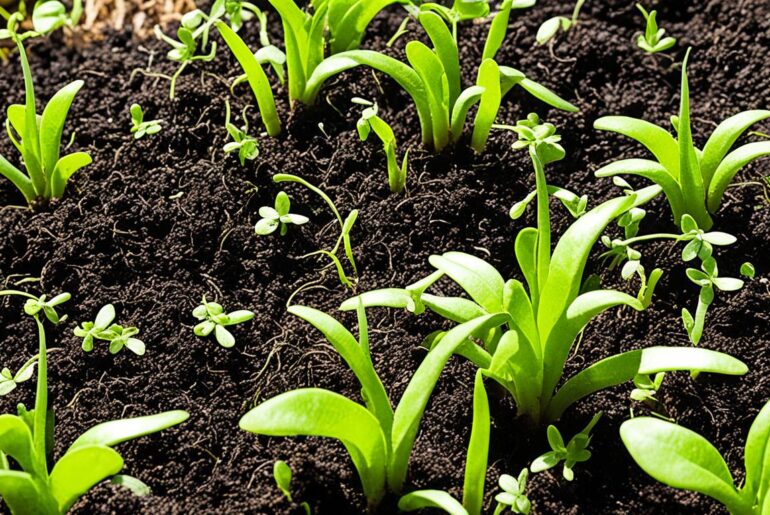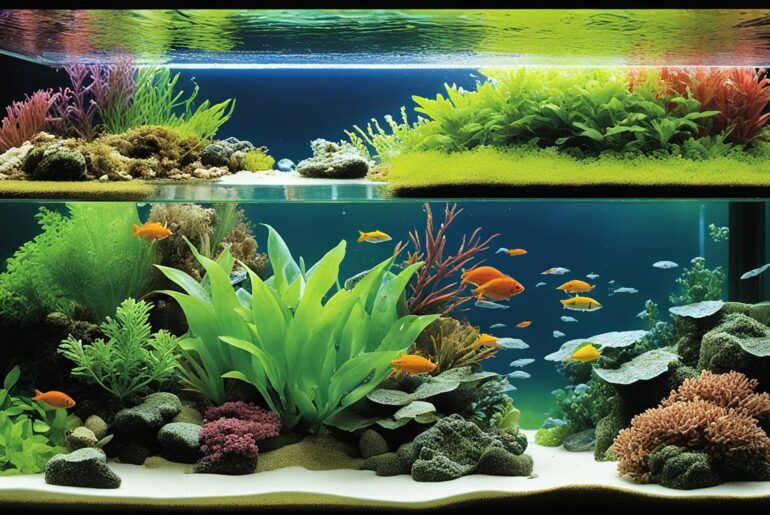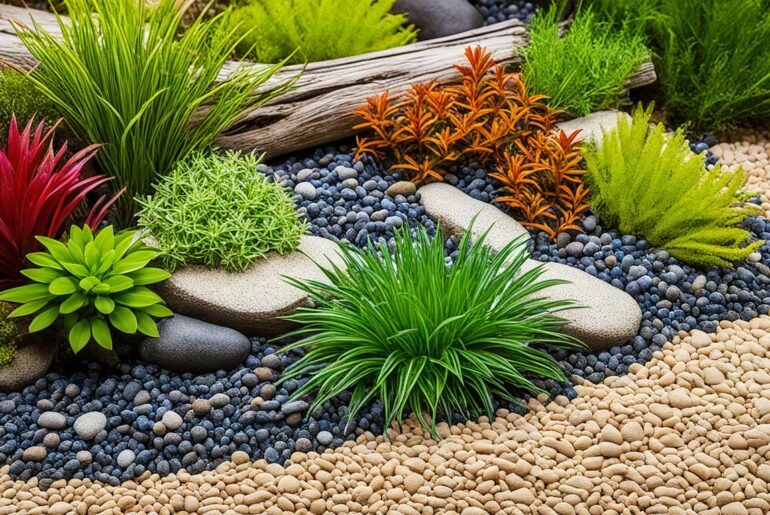As an avid aquarium enthusiast, I’ve always been passionate about creating the perfect underwater haven for my fish and plants. It’s a world of serenity and beauty, where the gentle flow of water and the vibrant colors of aquatic life can soothe even the busiest mind. But to truly bring this tranquil oasis to life, one crucial element cannot be overlooked – the substrate.
The substrate, or the material that lines the bottom of your aquarium, plays a vital role in supporting the health and growth of your aquatic plants. It provides a sturdy foundation for their roots and delivers essential nutrients that they need to thrive. But finding the right substrate can be overwhelming with so many options available.
That’s why I’ve dedicated countless hours researching and testing different lightweight substrate options, with the goal of finding the best ones for freshwater aquariums. I understand the frustration of trial and error, and I want to help you make an informed decision, saving you time and ensuring a successful aquarium setup.
In this article, I’ll share the top 3 lightweight substrate options that I’ve personally found to be highly effective in promoting plant growth and sustaining a thriving aquarium environment. Whether you’re a beginner or an experienced aquarist, these substrates will provide the foundation your plants need to flourish.
Key Takeaways:
- Choosing the right substrate is vital for the health and growth of your aquatic plants.
- I’ve researched and tested various lightweight substrate options to save you time and help you make an informed decision.
- In this article, I’ll share the top 3 lightweight substrate options for freshwater aquariums.
- These substrates provide essential nutrients and a sturdy foundation for plant roots.
- By choosing the right substrate, you can create a thriving and beautiful underwater oasis.
CaribSea Eco-Complete Planted Aquarium Substrate
When it comes to creating a lush and thriving planted aquarium, the right substrate is essential. One option that stands out in terms of both quality and performance is the CaribSea Eco-Complete Planted Aquarium Substrate.
This substrate is made from nutrient-rich volcanic soil, making it a natural choice for plant growth. It is biologically complete, containing essential bacteria and 25 micro- and macronutrients that provide the necessary nourishment for your aquatic plants. With CaribSea Eco-Complete, you can be confident that your plants will receive the nutrients they need to prosper.
What sets CaribSea Eco-Complete apart is its non-toxic and neutral black tone. Unlike some substrates, it doesn’t require the addition of a second non-carbonate substrate. This makes it convenient and eliminates the need for extra materials. It is available in a 20-pound bag, providing enough substrate to cover a standard-sized aquarium.
With its natural composition and nutrient-rich formula, CaribSea Eco-Complete Planted Aquarium Substrate is an excellent choice for any aquarist looking to create a beautiful and healthy planted aquarium.
Be sure to check out the other sections of this article to explore more lightweight substrate options for freshwater aquariums!
Seachem Flourite
When it comes to finding the perfect substrate for your aquarium, Seachem Flourite offers a fantastic alternative to traditional gravel. Made from porous clay, this nutrient-rich substrate provides a wealth of benefits for both your aquatic plants and the overall health of your aquarium.
One of the standout features of Seachem Flourite is its rich iron content. Iron is a crucial nutrient for plants, as it helps promote healthy growth and vibrant colors. Whether you have delicate stem plants or robust root feeders, Seachem Flourite will provide them with the nutrients they need to thrive.
Seachem Flourite is available in black and red colors, allowing you to choose the option that best complements your aquarium’s aesthetic. Whether you prefer a dark and dramatic backdrop or a pop of vibrant color, Seachem Flourite has got you covered.
Another advantage of Seachem Flourite is its versatility. It can be used on its own as a primary substrate or layered with other substrates for a customized look. Whether you prefer a minimalist sand bed or a combination of sand and gravel, Seachem Flourite provides the perfect foundation for your creativity.
One of the key advantages of Seachem Flourite is its chemical-free and pH-neutral formula. This ensures that it won’t negatively impact the water chemistry of your aquarium, making it safe for your fish and other aquatic inhabitants.
With Seachem Flourite, you can create a beautiful and thriving underwater landscape that your fish and plants will love. Its nutrient-rich composition, versatile usage options, and color variety make it an excellent choice for aquarium enthusiasts seeking a high-quality substrate.
So why settle for ordinary gravel when you can have the exceptional benefits of Seachem Flourite? Try it out for yourself and see the difference it makes in your aquarium.
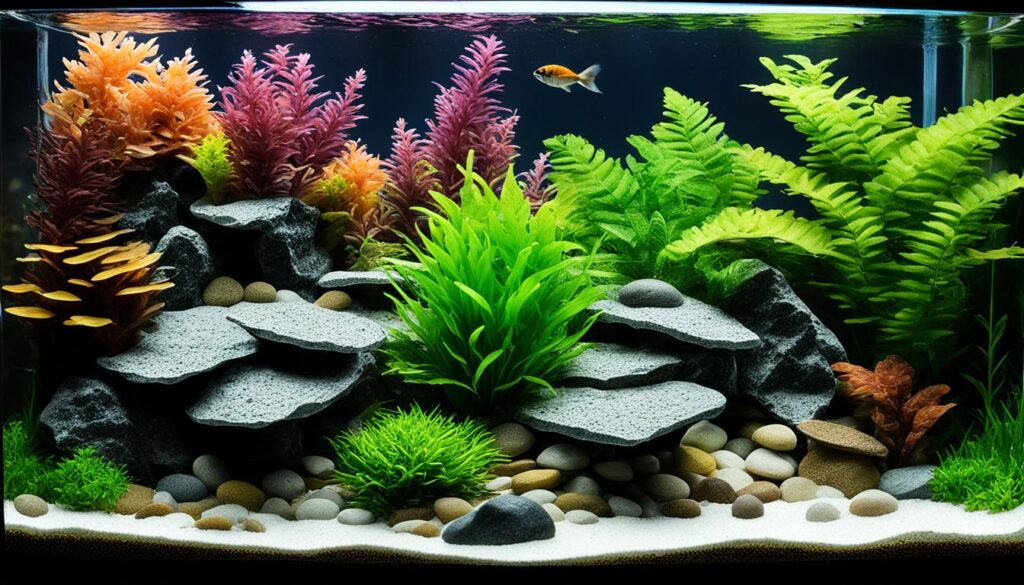
Fluval Plant Stratum
When it comes to low maintenance aquarium substrates, Fluval Plant Stratum is an excellent choice. This lightweight and porous substrate is specifically designed to promote the growth and spread of plant roots, creating a healthy and vibrant aquatic environment.
Fluval Plant Stratum is packed with active bacteria and essential nutrients that are crucial for pH maintenance and ammonia removal. These beneficial components create a balanced ecosystem within your aquarium, reducing the need for constant monitoring and maintenance.
One of the standout features of Fluval Plant Stratum is its compatibility with tanks housing snails and shrimp. It provides a safe and comfortable environment for these delicate creatures, allowing them to thrive alongside your aquatic plants.
Fluval Plant Stratum Sizes:
| Size | Weight |
|---|---|
| 4.4 pounds | 4.4 lbs |
| 8.8 pounds | 8.8 lbs |
| 17.6 pounds | 17.6 lbs |
Whether you have a small planted tank or a larger aquatic landscape, Fluval Plant Stratum caters to your needs with its range of sizes. Simply choose the weight that suits your setup and experience the benefits of this top-notch substrate.
With Fluval Plant Stratum, you can create a stunning underwater garden that requires minimal upkeep. Its ability to foster healthy plant growth and maintain a balanced pH level makes it an ideal option for aquarists seeking a low maintenance aquarium substrate. Give your plants the best foundation for growth with Fluval Plant Stratum.
Comparison and Recommendations
When it comes to choosing the best lightweight substrate for your freshwater aquarium, there are several options to consider. After careful evaluation, I have selected the following substrates as top recommendations:
1. CaribSea Eco-Complete Planted Aquarium Substrate
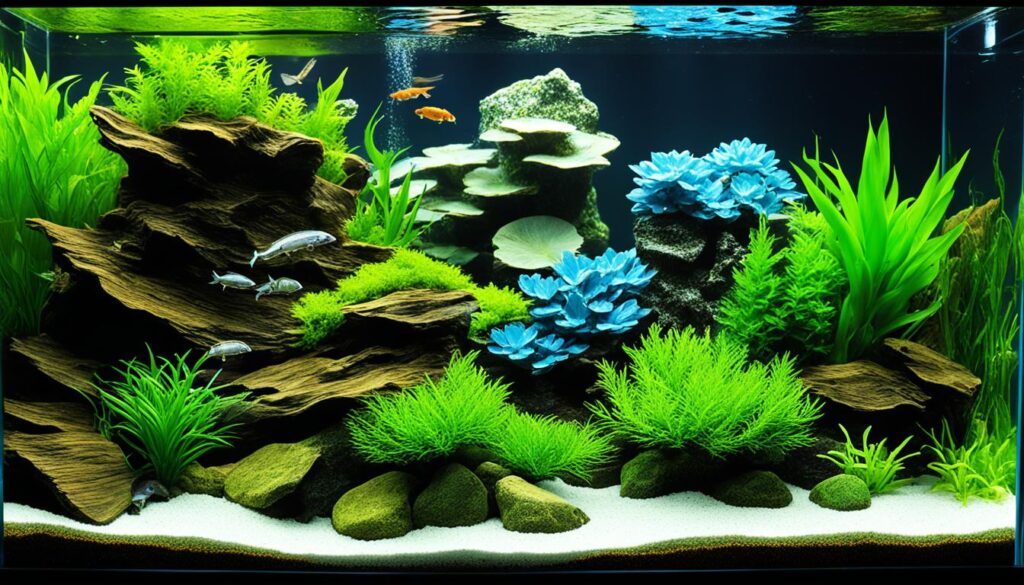
CaribSea Eco-Complete Planted Aquarium Substrate is my top recommendation for a freshwater planted aquarium. It provides a nutrient-rich foundation for plant growth and is biologically complete. This substrate is made of volcanic soil and contains essential bacteria and 25 micro- and macronutrients that promote optimal plant development. The neutral black tone enhances the aesthetic appeal of your aquarium without the need for a second non-carbonate substrate. Available in a 20-pound bag, it offers excellent value for your money.
2. Seachem Flourite
Seachem Flourite is another great option to consider. This porous clay substrate is rich in nutrients, particularly iron, which is vital for plant health. You can choose to use it alone or combine it with other decorative substrates to create a customized look for your aquarium. The formula is chemical-free and pH neutral, ensuring a safe environment for your aquatic life. It comes in black and red colors and is available in 15.4-pound and 7-pound bags.
3. Fluval Plant Stratum
If you have snails and shrimp in your tank, Fluval Plant Stratum is an excellent choice. This lightweight and porous substrate promote healthy plant root growth while creating an environment suitable for snails and shrimp. It contains active bacteria and essential nutrients required for pH maintenance and ammonia removal. You can choose from 4.4-pound, 8.8-pound, and 17.6-pound bags to suit the size of your aquarium.
Here is a comparison table to help you make an informed decision:
| Substrate | Key Features | Available Colors | Bag Size |
|---|---|---|---|
| CaribSea Eco-Complete Planted Aquarium Substrate | Nutrient-rich volcanic soil, biologically complete | Neutral black tone | 20 pounds |
| Seachem Flourite | Porous clay substrate, rich in iron | Black and red | 15.4 pounds, 7 pounds |
| Fluval Plant Stratum | Lightweight and porous, suitable for snails and shrimp | – | 4.4 pounds, 8.8 pounds, 17.6 pounds |
Based on their unique features, CaribSea Eco-Complete Planted Aquarium Substrate stands out as the best overall choice for a freshwater planted aquarium. However, Seachem Flourite and Fluval Plant Stratum offer excellent alternatives depending on your specific needs and tank inhabitants.
Next, we’ll discuss the importance of pH maintenance and monitoring in your aquarium. Stay tuned!
pH Maintenance and Monitoring
Maintaining the optimal pH level is crucial for the health of your aquarium. The pH level refers to the acidity or alkalinity of the water, and different fish and plants have specific pH requirements for their well-being.
To ensure a neutral pH level, the chosen substrate plays a significant role. Certain substrates, such as CaribSea Eco-Complete Planted Aquarium Substrate, are designed to buffer the water’s pH and maintain a stable environment for your aquatic life. These substrates help prevent drastic fluctuations that can stress or harm your fish and plants.
Regular monitoring of pH levels is essential to identify any deviations from the ideal range. It is recommended to test the pH of your aquarium water on a monthly basis using test kits or digital pH meters. This allows you to take necessary corrective actions promptly and avoid complications such as algae growth or ammonia buildup.
Aim for a pH level of 6.8 to 7.2, as this range is generally suitable for most freshwater aquariums. However, it’s important to note that some fish species and plants may have specific pH requirements outside of this range. Be sure to research the specific needs of your aquatic inhabitants and adjust the pH accordingly.
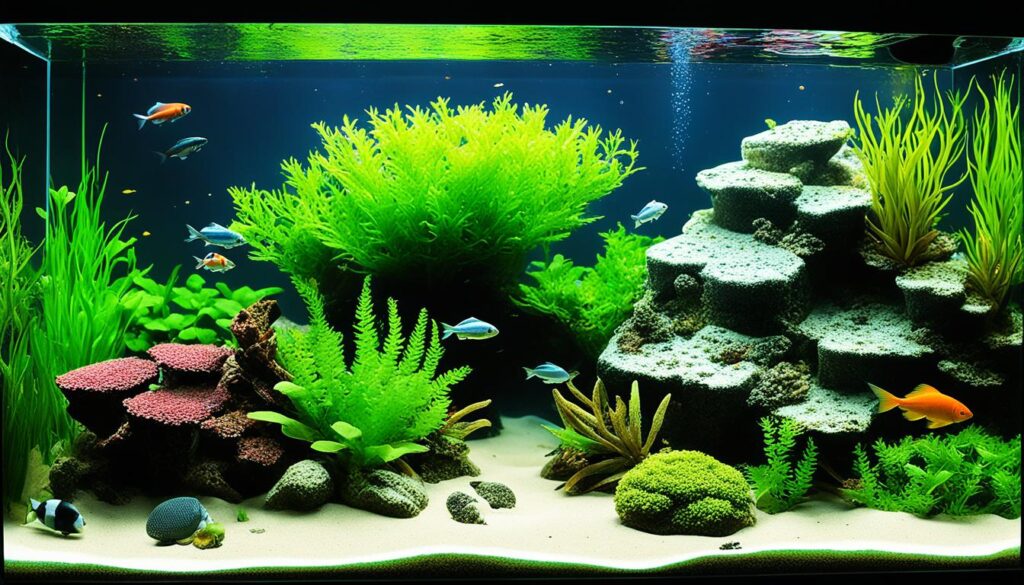
Monitoring and maintaining the pH level in your aquarium is an essential part of responsible aquarism. By providing a pH-neutral environment through the right substrate and regular monitoring, you can create a healthy and thriving ecosystem for your fish and plants.
Considerations for Hard Water
If your tap water has high levels of minerals like calcium and magnesium, known as hard water, it’s important to choose a substrate that can handle these conditions. Hard water minerals can have an impact on the pH level and overall water chemistry in your aquarium, which can affect the health of your plants and fish.
One suitable substrate for hard water aquariums is the Activ-Flora Planted Aquarium Substrate. This substrate is specially designed to handle high mineral content in the water. It contains the necessary components to maintain stable water conditions and promote healthy plant growth.
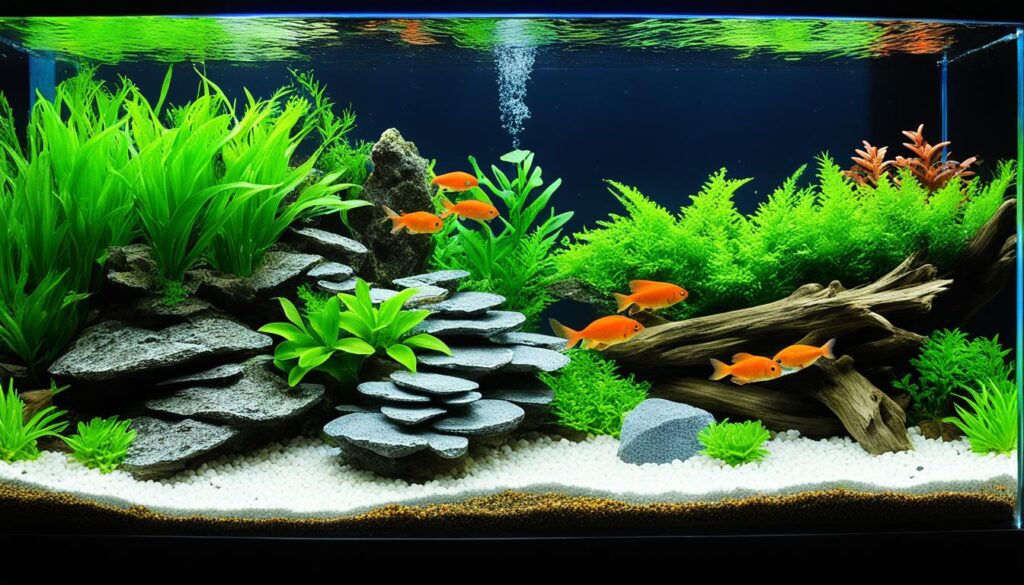
The Activ-Flora Planted Aquarium Substrate consists of a porous granulated material that aids in water filtration and nutrient absorption. It also contains active heterotrophic bacteria that help reduce naturally-occurring ammonia levels, ensuring a cleaner and healthier environment for your aquatic life.
Prior to selecting a substrate, it’s recommended to test your tap water to determine its hardness. There are various test kits available that can provide accurate readings of the mineral content in your water. This information will guide you in choosing the most suitable substrate and ensure the well-being of your aquarium inhabitants.
Nutrient Requirements for Plants
To ensure the healthy growth of plants in your aquarium, it is essential to provide them with the necessary nutrients. These nutrients include iron, phosphorous, magnesium, potassium, copper, and zinc. By selecting the right substrate, you can ensure that your plants receive these essential nutrients in the proper amounts.
The substrates mentioned earlier, CaribSea Eco-Complete, Seachem Flourite, and Fluval Plant Stratum, are specifically designed to meet the nutrient requirements of aquarium plants. Each substrate contains a unique blend of nutrients that promote optimal plant growth.
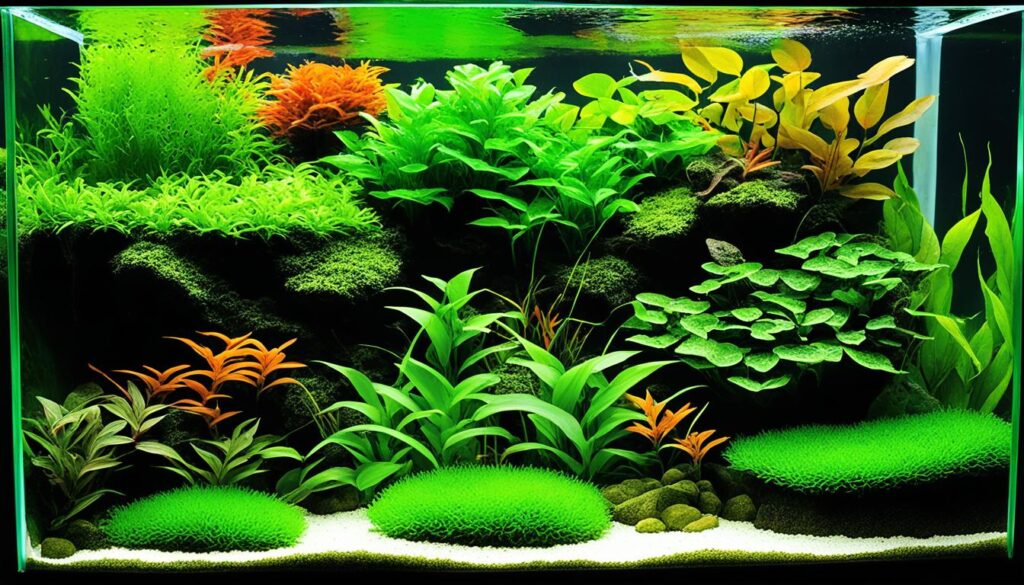
CaribSea Eco-Complete, for example, is made of nutrient-rich volcanic soil and contains 25 micro- and macronutrients. These nutrients provide a solid foundation for plants to establish strong roots and thrive. Seachem Flourite, on the other hand, is rich in iron, an essential nutrient for plant metabolism. It helps plants produce chlorophyll and carry out other vital biological processes.
Fluval Plant Stratum is another substrate that is specifically formulated to provide the necessary nutrients for plant growth. It contains active bacteria that aid in pH maintenance and ammonia removal, creating a favorable environment for plant roots.
By choosing any of these substrates, you can ensure that your aquarium plants have access to the nutrients they need for healthy growth and vibrant colors.
Comparison of Nutrient Content
| Substrate | Key Nutrients |
|---|---|
| CaribSea Eco-Complete | 25 micro- and macronutrients |
| Seachem Flourite | Rich in iron |
| Fluval Plant Stratum | Active bacteria for pH maintenance and ammonia removal |
As seen in the comparison table above, each substrate offers unique benefits in terms of nutrient content. Depending on your specific plant species and desired results, you can choose the substrate that best meets your aquarium’s requirements.
Substrate Depth for Different Plants
When it comes to creating a healthy and thriving aquarium, the depth of the substrate plays a crucial role, especially for rooted plants. The right substrate depth provides a stable anchor for plants, allowing their roots to grow deep and spread effectively.
For deep-rooted plants, it’s recommended to have a substrate depth of two to three inches. This provides enough room for the roots to establish themselves and access the necessary nutrients within the substrate. Deep-rooted plants often have more substantial root systems and require a deeper substrate for optimal growth.
However, it’s important to keep in mind that different plants have varying needs when it comes to substrate depth. Some plants, such as carpeting plants or mosses, have shallow root systems and may prefer a thinner substrate layer of around one inch. On the other hand, larger plants with extensive root systems may benefit from a deeper substrate layer.
To determine the recommended substrate depth for the specific plants in your aquarium, refer to the guidelines provided by the substrate manufacturer. These guidelines are typically based on the needs of various plant species and will help ensure that you provide the ideal substrate depth for your plants’ growth.
Factors to Consider:
- The type of plants you have: Consider whether your plants are deep-rooted or shallow-rooted.
- The substrate recommendations: Refer to the guidelines provided by the substrate manufacturer.
- The overall design of your aquarium: Consider the aesthetic appeal and the arrangement of plants at different depths.
Note: Proper substrate depth is essential for plant growth and helps maintain a stable environment for your aquarium. It allows plants to establish, grow, and thrive, contributing to the overall health and beauty of your aquatic ecosystem.
Remember, a well-maintained and balanced substrate depth is key to ensuring the longevity and success of your aquarium plants.
| Plant Type | Recommended Substrate Depth |
|---|---|
| Deep-rooted plants | 2 to 3 inches |
| Shallow-rooted plants | Around 1 inch |
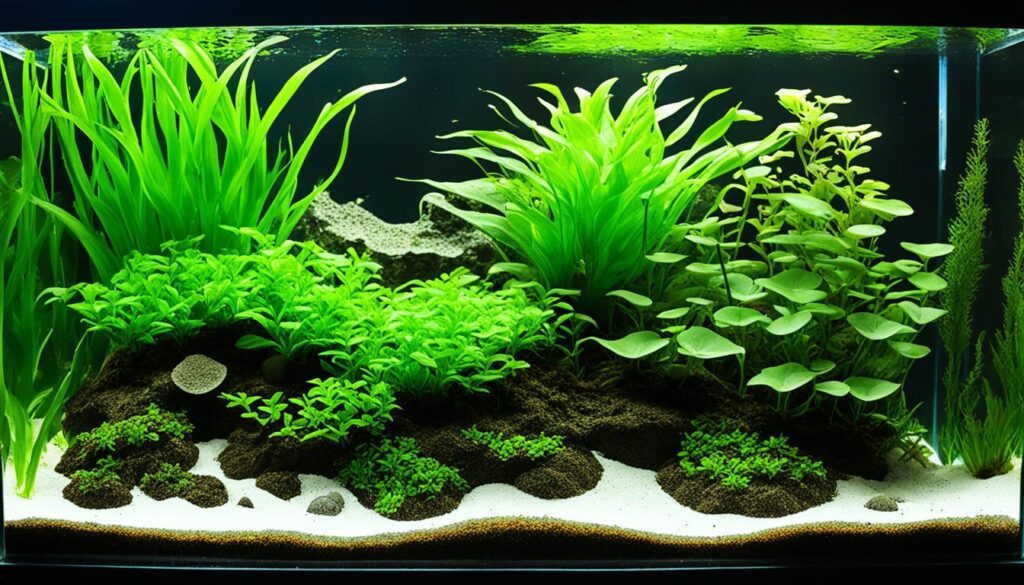
Expert Insights on Aquarium Plant Substrates
When it comes to selecting the right aquarium substrate for your freshwater planted aquarium, it’s always helpful to seek expert advice. Two renowned experts in the field of fish and aquariums, Shirlie Sharpe and Nic Tiemens, offer valuable insights and tips on choosing the best substrates.
Shirlie Sharpe on CaribSea Eco-Complete
“In my experience, CaribSea Eco-Complete Planted Aquarium Substrate is the top choice for freshwater planted aquariums. It’s a biologically complete substrate that provides essential nutrients for plant growth. The volcanic soil composition and 25 micro- and macronutrients make it a powerhouse for plant health. Plus, its neutral black color enhances the overall aesthetics of the aquarium. I highly recommend it.”
Nic Tiemens on Substrate Selection
“When selecting aquarium substrates, there are two key factors to consider: nutrient content and pH maintenance. Look for substrates that provide the necessary nutrients, such as iron, phosphorous, and potassium, to support optimal plant growth. Additionally, maintaining the right pH level is crucial for plant health. Choose a substrate that helps maintain a balanced pH environment suitable for your aquarium plants.”
By following the expert advice of Shirlie Sharpe and Nic Tiemens, you can make informed decisions when it comes to selecting the best substrates for your freshwater aquarium. Their insights underscore the importance of nutrient-rich substrates and maintaining the right pH level to promote thriving plant life in your aquarium.

| Expert | Substrate Recommendation |
|---|---|
| Shirlie Sharpe | CaribSea Eco-Complete Planted Aquarium Substrate |
| Nic Tiemens | Emphasis on nutrient content and pH maintenance |
Conclusion
Choosing the right lightweight substrate is essential for the success of your freshwater aquarium. After careful consideration, we have determined that CaribSea Eco-Complete Planted Aquarium Substrate, Seachem Flourite, and Fluval Plant Stratum are among the top options available.
When making your selection, it is important to take into account the specific needs of your aquarium, such as the types of plants you have and the water conditions. Each of these substrates offers unique benefits and characteristics, so choose one that aligns with your preferences and requirements.
Remember to regularly monitor the pH levels of your aquarium and supplement nutrients if necessary. This will ensure optimal plant growth and overall aquarium health. With the right lightweight substrate in place, you can create a beautiful and thriving underwater ecosystem for your aquatic plants and fish.
FAQ
What are the top lightweight substrate options for freshwater aquariums?
The top lightweight substrate options for freshwater aquariums are CaribSea Eco-Complete Planted Aquarium Substrate, Seachem Flourite, and Fluval Plant Stratum.
What is CaribSea Eco-Complete Planted Aquarium Substrate made of?
CaribSea Eco-Complete is made of nutrient-rich volcanic soil and contains essential bacteria and 25 micro- and macronutrients.
Is CaribSea Eco-Complete a natural and non-toxic aquarium substrate?
Yes, CaribSea Eco-Complete is a natural and non-toxic aquarium substrate that promotes optimal plant growth.
What is Seachem Flourite and can it be used with other substrates?
Seachem Flourite is a porous clay substrate rich in nutrients. It can be used on its own or with a decorative layer of substrate for a customized look.
What are the benefits of Fluval Plant Stratum?
Fluval Plant Stratum is a lightweight porous substrate that promotes plant root growth. It contains active bacteria and nutrients needed for pH maintenance and ammonia removal.
Which lightweight substrate option is recommended for a freshwater planted aquarium?
CaribSea Eco-Complete Planted Aquarium Substrate is the top recommendation for a freshwater planted aquarium due to its nutrient richness and biologically complete formula.
How do I maintain the optimal pH level in my aquarium?
Regular monitoring of pH levels is recommended. The chosen substrate should help maintain a neutral pH level. Aim for a pH level of 6.8 to 7.2 for most aquariums.
What should I consider if my tap water has high mineral levels?
If your tap water has high mineral levels, known as hard water, choose a substrate that can handle these conditions. Some substrates, like Activ-Flora Planted Aquarium Substrate, contain active bacteria that help reduce ammonia levels.
What nutrients do aquarium plants need from the substrate?
Aquarium plants need nutrients such as iron, phosphorous, magnesium, potassium, copper, and zinc. The substrates mentioned earlier provide these essential nutrients for healthy plant growth.
How deep should the substrate be for different aquarium plants?
The recommended substrate depth depends on the type of plants. Deep-rooted plants typically require a substrate depth of two to three inches. Follow the recommendations provided by the substrate manufacturer for best results.
What do experts say about aquarium plant substrates?
Shirlie Sharpe, a fish and aquarium expert, recommends CaribSea Eco-Complete as the top choice for a freshwater planted aquarium. Nic Tiemens, co-founder of Infinity Aquarium Design, emphasizes the importance of nutrient content and pH maintenance when selecting substrates.

